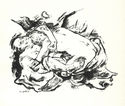
19th, 20th & 21st Century Fine Prints
707-546-7352 · fax 707-546-7924 · web: www.annexgalleries.com · email: artannex@aol.com
Willi Jaeckel Biography
Willi Jaeckel
German
1888–1944
Biography
Willi Jaeckel, sometimes spelled "Willy," painter and printmaker, was born in Breslau in 1888, the son of a forest ranger. Poor health kept him from following in his father's footsteps, and as a teenager he enrolled at the Breslau art school to redirect his interest. Following graduation in 1908, he entered the Dresden Academy of Fine Arts, studying painting under Otto Gussmann.
He was influenced by the German Expressionists but never considered himself a part of the movement. In 1913 Jaeckel moved to Berlin, where he became a member of the Berlin Secession in 1915. However, after four years of freelance work he was elected member of the Prussian Academy of Art, a more conservative art school that didn't embrace Modernism as the country faced an increasingly right-wing identity crisis following World War I. In 1925 he took a position as an art teacher at the University of the Arts, where he was a popular teacher and in 1933 was named Associate Professor.
It was a short lived career, as by 1934 his work was deemed degenerate by the Nazi regime and he was dismissed from his post. After student protests, he was reinstated, but he suffered for it through the academy's back channels: his students weren't allowed to graduate, and his works were continually barred from exhibition, though whether due to their Modernist nature or his own actions as a Secessionist were unclear. In his own protest, he painted "Plowman in the Evening," a commentary on the Nazi concept of "Blood and Soil."
In 1943, his studio was lost in a bomb raid. Months later, Jaeckel himself was killed in another. Because of his labeling as a "degenerate," many of his artworks were removed from the city of Berlin by Nazi officials during the war, ironically allowing the artist's remaining oeuvre to survive further destruction. Many of these works are now in public and private collections throughout Europe and the United States.

